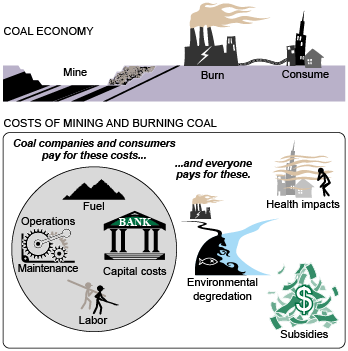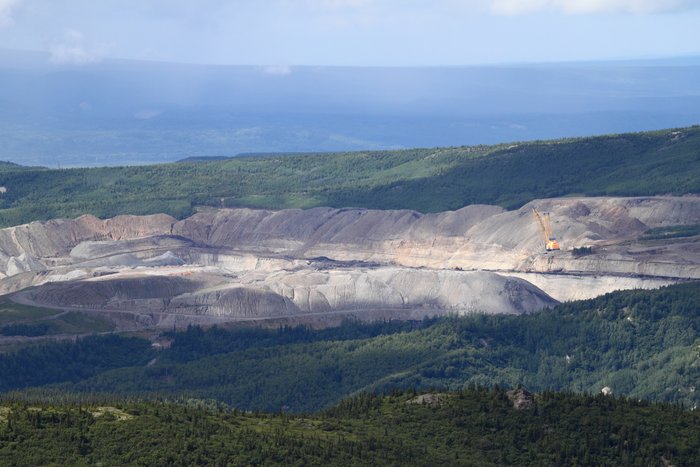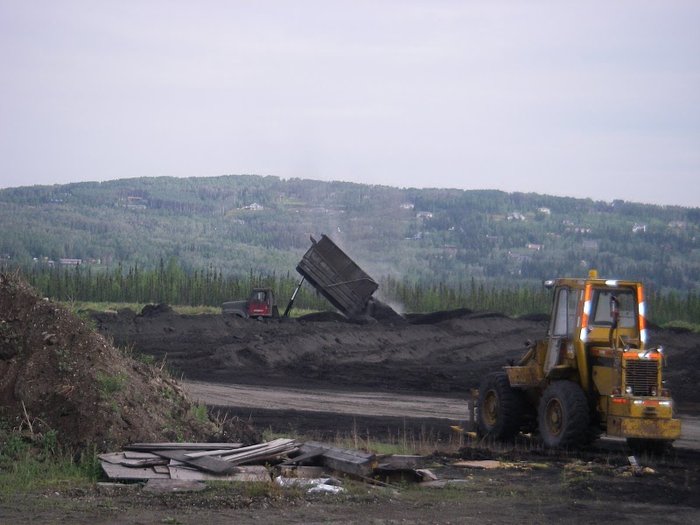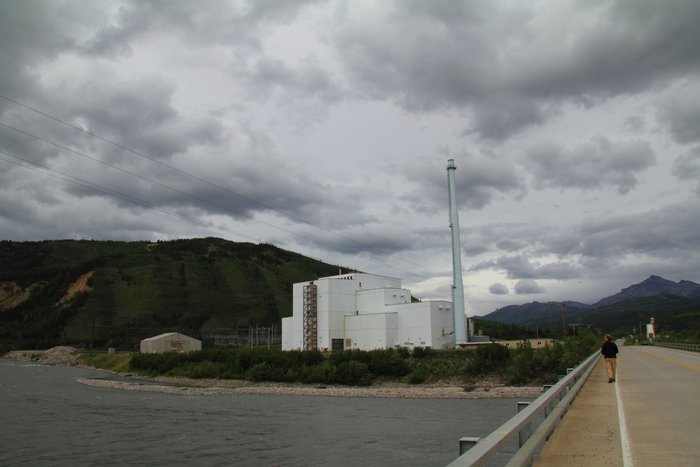
To the electricity customer, coal is relatively cheap. But missing from the sticker price are coal’s major impacts on ecosystems, human health, and our economy.
- People are sickened by pollution from coal fired power plants, shortening their lives and burdening the health care system with costly care.
- Fish are poisoned when coal mines dump waste into streams, starving their predators, depriving subsistence fishermen, and straining stocks that support commercial fisheries.
- Future generations will be heavily impacted by global warming from the carbon dioxide that burning coal spews into the air.
- As taxpayers we pay to subsidize coal use and clean up its aftermath.

Collectively, these are known as “externalized costs”, because they are not paid by those directly involved in the buying and selling that sets the market price (the coal mining companies, the coal-using power plants, or their electricity customers). Coal has many externalized costs, therefore its market price doesn’t reflect its “True Cost.” Although it appears to be cheap to the buyer, it is much more expensive to society as a whole. For a more detailed discussion of True Cost, see our article here.
Worldwide these externalized costs were estimated to exceed $450 billion in 2007. We estimated total economic value of coal in that year to be $210 billion, less than half of the externalized costs. To make this estimate we assumed that the 2007 US open market price of ~$30 per ton was representative of the world open market and multiplied this by the world coal consumption in 2007 of about 7 billion tons.
Similarly, in 2009 the National Resource Council calculated that the total hidden costs of coal combustion in the United States had exceeded $62 billion in 2005. In 2010, a detailed economic analysis of the costs of downwind pollution (primarily from coal plants) concluded that each dollar spent on airborne pollution controls saved $50-100 in annual costs downwind. Another study, released in Feburary 2011, estimated that the true cost of coal was up to $500 billion annually in the United States alone. This study further calculated that if all the externalized costs of coal were accounted for, it would at almost 18 cents/kWh to the price of coal. Yet another study, also released in February 2011, looked in detail at the benefits of increased electricity generation versus the much larger detrimental effects of coal consumption. A detailed report on the true cost of energy released in May 2011 calculated the true cost of coal to be 170% of the retail price. An analysis in August 2011 found the external damages caused by coal combustion to be about twice the “value added” of the commodity. A 2013 report on surface mountaintop mining calculated that to meet US coal annual demand from mountaintop mining would require the destruction of 310 square miles of mountains.
Habitat Destruction

Most coal mining in the U.S. is surface mining, which includes strip mining and mountaintop removal. In surface mines, the original ecosystem at the mine site is destroyed in the process of removing the coal. Coal companies are required to plant vegetation to reclaim the site after mining, restoring the original ecosystem may be difficult, particularly in wetlands areas. Mining destroys fish and wildlife habitat, which has rippling effects not only on their populations, but on the human residents that rely on them.
Beyond the footprint of the mine itself, coal mining impacts surrounding lands, discharging mine runoff into nearby waterways and sending coal dust across the landscape. Coal dust particles and discharged sediment from coal mining can reduce life expectancy of fish, damage their immune systems, and suffocate fish eggs.
Pollution and Health Impacts
Mining and burning coal releases a number of toxic pollutants, some of which remain behind as solid waste, and some of which are released into the atmosphere. These pollutants are responsible for a large number of illnesses and premature deaths, both to people directly involved in the industry and people worldwide.

Coal combustion wastes (CCW) include ash, sludge, and boiler slag left over from burning coal to make electricity. These wastes (120 million tons/year in the US) concentrate toxins such as arsenic, mercury, chromium, cadmium, uranium and thorium. In addition, these wastes create an expensive storage problem “in perpetuity”. Coal combustion emissions released into the atmosphere contain nitrous oxides which are responsible for industrial and urban smog, sulfur dioxide which is the primary reactive agent behind acid rain, mercury which accumulates in the food chain, and large amounts of carbon dioxide which is the most important greenhouse gas contributing to climate change. Coal mining itself also releases significant amounts of methane, another extremely potent greenhouse gas. Coal mining is responsible for over 25%(2.1 MB)of the energy-related methane emissions in the US.
Coal dust in mines and near storage and transport facilities contributes to serious respiratory illnesses such as asthma and Pneumoconiosis (black lung). Solid combustion wastes such as fly ash pollute groundwater near storage facilities, contaminating individual and community water supplies.
Airborne pollutants have a larger footprint. Despite air pollution regulations, toxic emissions (soot, sulfur dioxide, nitrous oxides) from coal-fired power plants are estimated to be responsible for thousands of deaths due to lung disease each year in the US and Canada. A government study in Ontario found that the coal-fired plants in that province alone were responsible for an average annual total of about 660 premature deaths, 920 hospital admissions, 1090 emergency room visits, and 331,000 minor illness.
Coal-fired power plants are a major source of atmospheric mercury, which accumulates in the food chain and can damage the developing nervous systems of human fetuses, as well as leading to reduced immune function, weight loss, reduced reproduction rate, mental defects and other neurological problems.
Economics
All of the impacts of coal have an economic cost, from the jobs lost by fishermen downstream of a coal mine, to the health care costs of the people sickened by coal-fired power plant pollution, to the cost of cleaning up spills of toxic coal waste.

Some of the simplest economic costs of coal come in the form of subsidies and tax breaks which are not reflected in the market price of coal (for example the estimated $4.6 billion in coal-related subsidies in the 2009 stimulus package). Coal mining and combustion projects require major investments, and the risks and costs of those investments are often passed on to taxpayers via infrastructure subsidies and loan guarantees. An extreme example of this is the Healy Clean Coal Plant (HCCP), which has cost the State of Alaska and the Federal Government nearly $300 million since the mid 1990’s yet is not producing power in return. Similarly, a recent study in Kentucky determined that the government spends $115 million more on subsidies for the coal industry in the state than it receives in taxes or other benefits. We have calculated that coal pays only 5% of it’s market value to the state of Alaska, even though the nominal rates are much higher.
Taxpayers also pay the costs of cleaning up environmental disasters caused by the coal industry. Cleanup of the recent coal ash spill in Tennessee is estimated to cost up to $1 billion, not including pending litigation. Now that the cleanup at this site has been taken over by the EPA under the Superfund law, most of this cost will be borne by the US taxpayer.
The health impacts of coal pollution have enormous economic costs, through health care costs and lost productivity. The Ontario government study estimated these costs as billions of dollars within Ontario alone. A similar recent study in West Virginia found that the cost associated with premature death due to coal mining was five times greater than all measurable economic benefits from the mining. Interestingly a recent study in Illinois found that coal mining in the state resulted in a net cost to the state of almost $20 million, without even including any externalities.
Other industries depend on the ecosystems coal mining destroys. This economic impact on industries such as recreational fishing, commercial fishing, and tourism is particularly relevant in Alaska. Almost 55,000 direct jobs (full time equivalent basis, FTE) are closely linked to the health of Alaska’s ecosystems. These jobs make up more than a quarter of Alaskan FTE employment and produce almost $2.6 billion of income for Alaska workers. These 55,000 ecosystem-dependent jobs dwarf the 350 estimated jobs that would be created by a project such as the Chuitna Coal strip mine.
Negative effects on the economy lead to worse health in the population, which has an impact on health care costs, compounding the economic impact. Some people have used this to argue that coal has additional benefits to society. The argument is that coal provides cheap electricity, which is a boon to the economy, therefore health is improved, and health care costs are lowered. While this additional health effect should indeed be considered, it should be applied after the economic impacts discussed above. Once the costs of pollution, global warming, and habitat destruction are added to the benefits of cheap electricity, the economic impact of coal is no longer positive, and this additional health effect only makes it even more costly.
See our related articles onTrue Cost and True Cost of Electricty Generation.
Further Reading
- > Greenpeace-commissioned study to quantify the externalized costs of coal worldwide in 2007
- > Hidden Costs of Energy: Unpriced Consequences of Energy Production and Use (National Resource Council, 2009)
- > Report: The Hidden Cost of Harmful Pollution to Downwind Employers and Businesses (2010). Prepared by the Clean Air Council
- > "Estimating the Global Public Health Implications of Electricity and Coal Consumption" (2011). Published in Environmental Health Perspectives.
- > Environmental Accounting for Pollution in the United States Economy(2011).
- > Coal's assault on human health (Physicians for Social Responsibility, 2009)
Created: Jan. 19, 2018